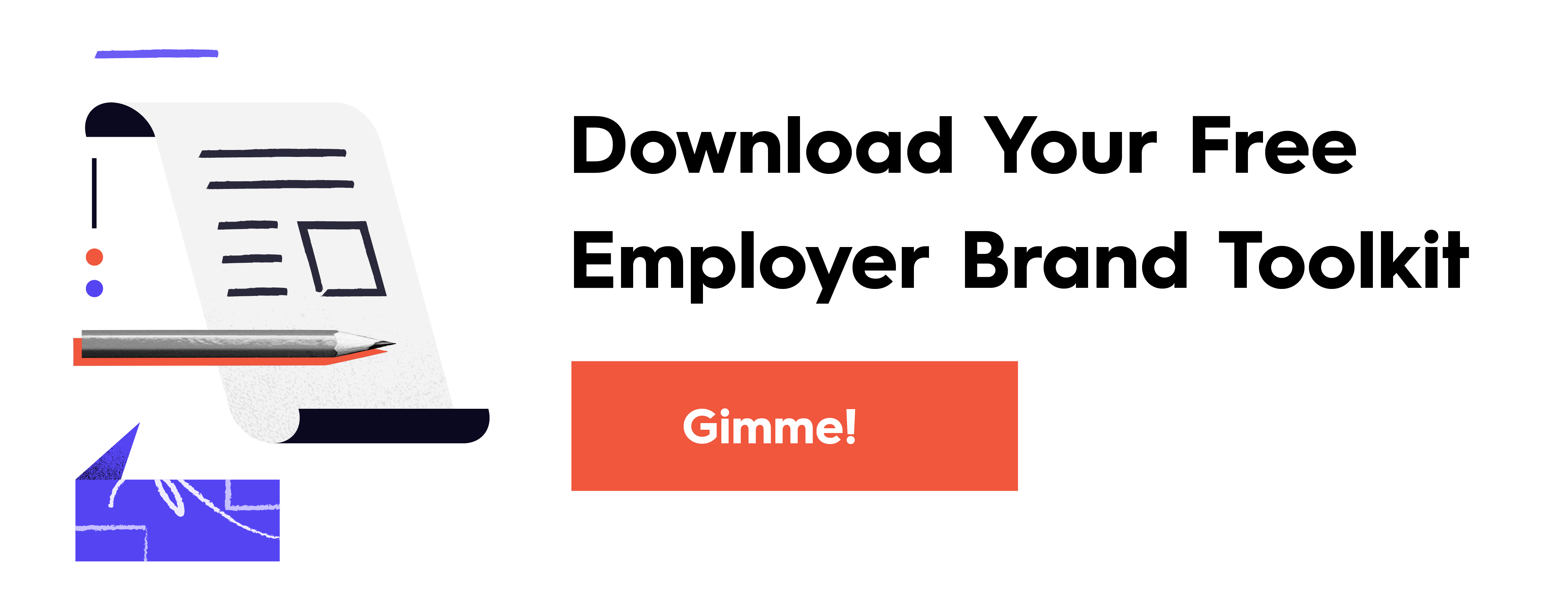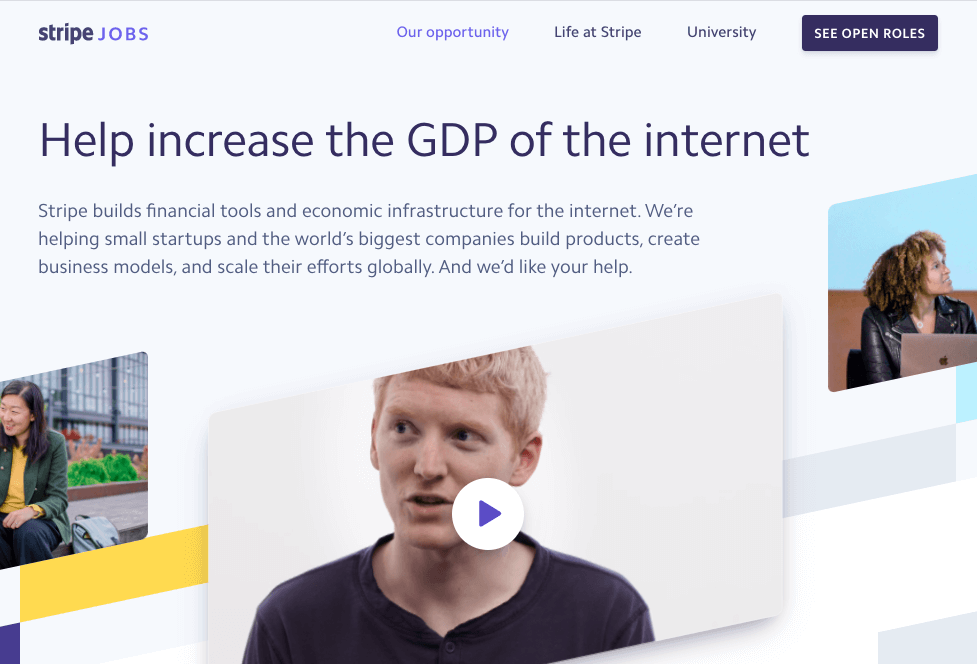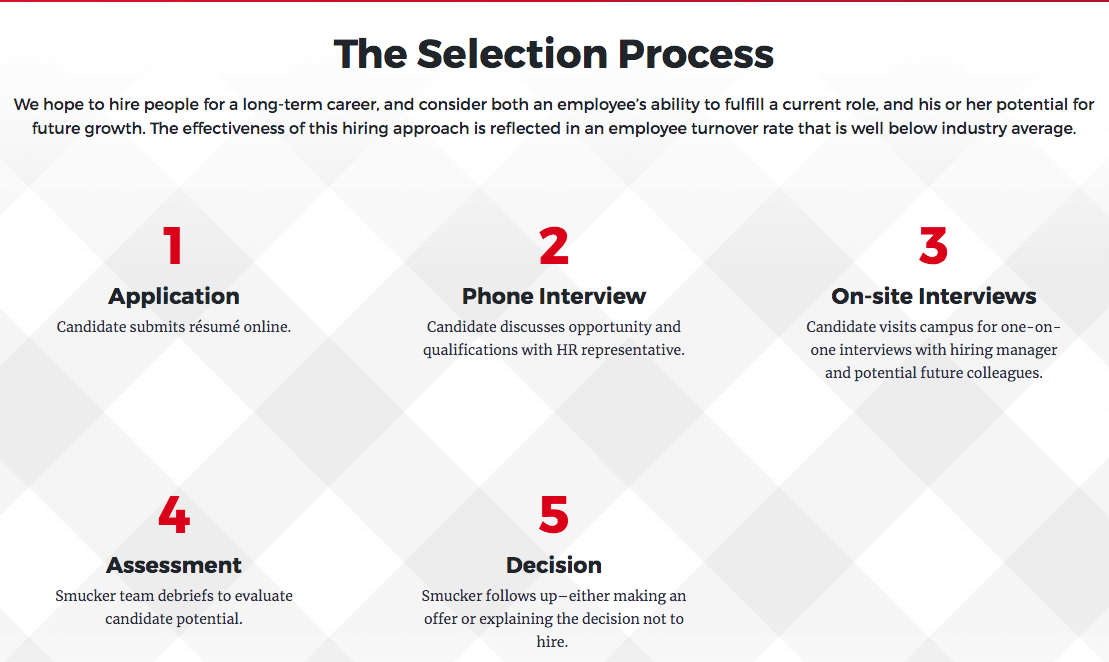No matter how great your company is, finding the right talent is tricky. You need to reach the right candidates, show them why they should want to work for you, and create a consistent experience, from the first time they encounter your brand, to the moment they accept the job offer, to their first day (and beyond). It may seem like a tall order, but you can do it—and do it better than your competition—by telling your employer brand story in words and actions at every touchpoint along the way. Not sure what that looks like? We’ll show you.
Here, we cover the simple ways you can infuse your brand story into the hiring process, making the most of the tools and content at hand.
Before You Start
Before we dive into the different ways you can connect with people throughout the hiring process, it’s helpful to understand what prospective employees are thinking at every stage of the journey. To get this insight, we recommend mapping your employee experience journey. This will give you an objective look at your brand’s strengths and weaknesses at each stage, and show you what stories you need to tell to get people to take the next step. Use the free template in our employer brand toolkit and see our guide to map your employee journey.

Once you’ve done that, you can look for more ways to bring your brand story to life.
10 Ways to Tell Your Employer Brand Story
During the awareness, consideration, and decision stages of the hiring process, it’s important to communicate your brand clearly to pique people’s interest. The tips we’ve included here will help you grab attention, make emotional connections, and encourage people to take the next step—hopefully.
1) Know your main differentiators—and highlight them.
To connect with people, you need to tell stories about your employer brand that give them a sense of who you are, what you care about, what you offer, why you’re different, etc. One of the best ways to do this is to conduct an employer competitive analysis, wherein you look at how your competitors are positioning themselves. This can help give you insight into what’s unique about your brand.
Once you’ve done that, identify the main 3-5 things that make your employer brand special. These things can become story “pillars” to help you ideate content that will grab people’s attention and entice them to apply.
For more ideas to highlight your selling points, follow these 10 tips to tell your brand story, and explore these unique examples of how other brands do it.
2) Identify the traits you want in a new hire.
A good employer brand is respectful of people’s time and energy, so you don’t want to encourage people to apply for jobs they aren’t right for.
Before you begin your candidate search or outreach, get total clarity on what position you need filled and the skills required (e.g., hard vs. soft skills), as well as the traits you want in all employees. Those traits are what drive your culture and will help you find people who can enhance it.
- Tell stories that showcase those traits. For example, if a generous spirit is a core trait, you might share an Instagram post around your recent volunteering initiatives. This will help you attract the people who share that passion.
- Update your job descriptions. Great job descriptions help you attract a better pool of applicants. Write clear, compelling job descriptions that detail what you’re looking for, but keep in mind that job descriptions can encourage or alienate potential applicants, depending on the info they contain. For more tips, see The Muse’s guide to write inclusive job descriptions.
[bctt tweet=”43% of workers find job descriptions to be very generic and not specific to the actual job.”]—2020 Job Seeker Nation Survey
Example: Crayola outlines their cultural values on their site, detailing the beliefs and behaviors they promote. These same values (e.g, “Foster a giving spirit”) translate to their social content in something as simple as a craft project that promotes kindness.
3) Write a compelling Employer Value Proposition.
Just like a regular value proposition, an EVP is a succinct statement that “sells” your company to prospective hires. It tells them why they should want to join you and what they’ll get in return. It also works as a beacon, attracting the people most interested in helping you achieve your mission.
For more tips to create yours, follow our guide to craft an EVP in 5 steps.
Example: Honda features a compelling EVP that is equally informative and inspiring.

4) Optimize your website to tell your employer brand story.
Your website is one of the most important properties when it comes to employer branding. It should showcase your brand thoroughly and delight, intrigue, and impress potential candidates.
- Share your Brand Heart. Your Brand Heart is comprised of your purpose, vision, mission, and values. These principles guide your business and can be a great differentiator, helping you connect with prospective employees who share your values. Follow our guide to articulate your Brand Heart if you haven’t done it before.
- Answer their questions—before they ask them. Think about what someone would want to know about working for your brand from the jump. What are your values? What benefits do you provide? What type of work do you do? How do you demonstrate your commitment to D&I? Use your website content to answer these types of questions. (BTW, here are 5 big questions people will want answered during the hiring process.)
- Add video. A simple video gives people a peek behind the curtain, showing them what their coworkers, office, and culture might be like. This could take the form of employee interviews, day-in-the-life content, a tour of your headquarters, etc.
Example: Stripe has a robust Jobs page, sharing just about everything you’d want to know about the company, including mission, values, cofounder video, podcast interviews, and more.

5) Evaluate your application process.
What is your application software like? Is it clunky and cold (e.g., no sense of your brand)? Do you send timely confirmation emails? Do you let people know what to expect or next steps? Make the most of tools available, including applicant-tracking systems, templates, etc. You can even ask people for feedback once they submit to help you improve the process.
- Keep people in the loop at all times. Learn more about the 6 emails you should be sending applicants.
- Use your brand voice. You want people to have a strong sense of who you are at every stage. Infuse your brand personality into your emails, CTAs, etc.
- Simplify where possible. The application process can be stressful. Only make candidates do the work they need to do.
Remember: The easier your process is, the more people will complete their applications.
[bctt tweet=”58% of candidates rate great communication as the top factor in creating a positive candidate experience.”]—2020 Job Seeker Nation Survey
6) Prepare candidates for the interview.
The interview process can be nerve-wracking, but the more steps you take to make it easier, the more people will feel cared for and empowered to give you their best. You can easily do this through content. Share your tips to get hired, clearly outline the hiring process, and let people know what types of interviews you conduct. This simple courtesy speaks volumes about your employer brand.
Example: Smuckers includes a “How We Hire” section on their site, detailing their 5-step process.

7) Make the most of different channels.
There are many ways to reach potential employees, including:
- Brand/product marketing
- Broadcast (TV/radio)
- Outdoor (billboards, bus stops)
- Social networks
- Referrals
- Job search platforms
- Direct contact
- Events
- Experiential/guerrilla
Tailor your content to meet people where they’re at. Whether you’re highlighting the work you do, the benefits you provide, or the culture you’ve created, you can experiment with these 25 types of content to connect with people across different channels.
8) Craft a thoughtful offer letter.
The closer you get to closing the deal, the more you need to show care and consistency in your words and actions. You want to establish a positive dynamic from the beginning, especially as you approach negotiations (which can be tricky to navigate). Provide context for your offer, and encourage an open dialogue.
We like to set up a follow-up call when we send an offer letter as a gesture of good will. This lets candidates know we’re open to talking and willing to have difficult conversations.
9) Handle rejections with empathy.
The way you approach rejections says a lot about your employer brand. No one likes to hear “no,” especially when they’ve invested the time to go through the interview process, but there are ways to do it while preserving as much good will as possible.
Remember, too, that it might be you who gets rejected by a candidate. Keep your composure, model your values, and do your best to leave things on a good note. So frequently this is not the end of your relationship, so you want to leave the door open for the future.
10) Reinforce your brand through onboarding.
Once people have accepted your offer, you need to prove that everything they were sold on isn’t just talk. Those first 30 days are especially crucial to set the stage for a great employee experience.
- Set expectations. Let them know what to expect, how their schedule will be structured, etc.
- Welcome them effectively. Celebrate their arrival through team welcomes, give them Facetime with leadership (e.g., lunch), and check in regularly.
- Turn onboarding into an adventure. It’s easy to overwhelm people with a ton of information when they first arrive. Look for opportunities to make onboarding a little easier through gamification.
For more tips to up your game, see Playficient’s ideas to make onboarding fun.
[bctt tweet=”46% of people who left a job in the first 90 days say it’s because their day-to-day role wasn’t what was expected.”]—2020 Job Seeker Nation Survey
Keep Investing in Your Employer Brand
Just because you’ve hired a great person doesn’t mean your work is done. One of the best things you can do for your current and future employees is continually nurture and improve your employer brand. For more tips to do that…
- See our complete guide to build an employer brand.
- Learn more about the keys to a strong employer brand.
- Conduct an employer brand audit to identify your strengths and weaknesses.
- Find out how to strengthen the core pillars of your culture.
- Bookmark these 50 tools to help you with all areas of employer branding.
That said, we know this work can be overwhelming if you don’t have the bandwidth or resources available to you. If you need any help crafting your employer brand strategy, let’s chat.





